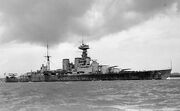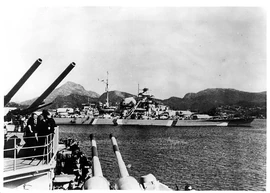
The cruiser Prinz Eugen.
Operation Rheinübung was an operation in which the German warships Bismarck and Prinz Eugen would stop allied shipping headed to Great Britain.
Perparations and Planning[]
Erich Raeder, the leader of Deutschland Kriegsmarine, found out that Hitler was planning to attack the Soviet Union. It was clear that Hitler's interest would favor the Heer, and Raeder planed Operation Rheinübung to appeal to the importance of naval forces.

The battlsecruiser Scharnhorst.
Originally, four ships were assigned to this mission: Bismarck, heavy cruiser Prinz Eugen, battlecruiser Scharnhorst, and battlecruiser Gneisenau. However, Gneisenau took severe damage on its shaft due to torpedo attack from British aircraft carriers in Brest and Scharnhorst was undergoing heavy repair on her engine. Lutjens requested Raeder to delay the operation until either Scharnhorst or Gneisenau would be able to join the operation. However, Raeder rejected this request as he was afraid Hitler would spend more resources and attention on the Heer. On May 1941, Cpt. Lutjens and his fleet left Gotenhafen (Now Gdynia, Poland) and headed towards the North Atlantic.
Battle of the Denmark Straight[]

HMS Hood.
In the beginning, they tried to avoid being spotted. However, due to its massive size, the fleet was eventually seen by a British patrol plane at Grimstadfjord. Immediately, the British Navy assigned L.E. Holland's fleet to chase the Bismarck. The day after the decision, the battleship HMS King George V, aircraft carrier HMS Victorious, and battlecruiser HMS Repulse were ordered to target Bismarck under John Tovey's command.
A few days later, on the way to the mission in the Atlantic Ocean, the Prinz Eugen and Bismarck crossed the Denmark Straight (Greenland - Iceland). The British ships HMS Norfolk and HMS Suffolk spotted Bismarck with Prinz Eugen over thick mist, around 10km away from them. The two ships panicked (as Bismarck' s main gun had range of 30km), and sent radio signal to the British Navy to alert them to the ships' location. Soon, Bismarck opened fire, forcing the Norfolk and Suffolk go on the run with the aid of smoke screen. Neither side was hit due to thick mist. However, Bismarck' s main gun radar got jammed due to the shock from its massive guns. Thus, Prinz Eugen took up the lead and Bismarck followed behind. Norfolk and Suffolk followed behind them without being spotted, updating their commanders on the Bismarck' s location.
Shortly after the encounter, Admiral Holland's fleet - containing the HMS Hood and HMS Prince of Wales - approached the German task force. However, Admiral Holland made a critical misjudgement: he mistook Prinz Eugen as Bismarck (they had almost same structures of bridge and guns, and Prinz Eugen was in the lead), dashed at full speed towards Prinz Eugen with the Hood and opened fire to her with forward guns. When he realized his mistake, Bismarck had already opened fire on his ship.

The German battleship Bismarck.
As Hood turned her turrets towards Bismarck, Prinz Eugen shot her in the midsection, causing the deck to catch fire. Shortly after, Bismarck' s 5th salvo of shells scored a direct hit on Hood' s ammunition magazine, causing loaded shells and other explosives to go off. Hood broke down in half and quickly sunk under water. Admiral Holland died with nearly all of his crew. Out of 1418 sailors, only three managed to survive the sinking. Prince of Wales attempted to dodge the debris of Hood, but ended up getting closer to Bismarck. Prince of Wales took severe damage, including a direct hit on her conning tower, completely destroying it and causing all the officers within to die (except for Cpt. John Cateral Leach). However, Prince of Wales managed to escape the area. Bismarck took two direct shots from the fleeing battleship, causing water to leak into her boiler and cracking her fuel tank, causing the heavy fuel to leak and leave black trace behind. Prinz Eugen did not take any damage, however.
As Bismarck was severely damaged, Cpt. Ernst Lindemann suggests to return to a port in Germany. However, Admiral Lutjens makes decision to dock Bismarck at Brest. As Prinz Eugen did not take any damage, only she remained to complete the mission.
The sinking of the Hood shocked the British Navy. John Tovey ordered to bring the aircraft carrier HMS Ark Royal, as well as cruisers HMS Renown and HMS Sheffield (all three of which belong to the Mediterrean Fleet) to proceed to Northern Atlantic to hunt down Bismarck, under Admiral James Somerville's command.
John Tovey's main fleet approached Bismarck from 120 miles away. He ordered the aircraft carrier HMS Victorious to send Swordfish bombers to attack Bismarck. Out of the nine planes, just one lost its course, and eight of them released their torpedoes towards Bismarck, scoring one hit on her belt. However, the attack did not do any major damage to Bismarck. The Swordfish group returned to Victorious. The next day, at dawn, Tovey's fleet lost Bismarck in spite of their hard effort. However, Admiral Lutjens did not realize that Bismarck was no longer being tracked, so he continued sending radio signals to the mainland. The British Navy spotted the radio signal, but completely mistook Bismarck' s location and lost track of it. The next day, May 26th 1941, patrolling Catalina flying boats spotted Bismarck. However, the ship was already far away from Tovey's fleet, only 800 km from the nearest German-occupied port. Bismarck was scheduled to enter the area of which Luftwaffe had aerial domination within a day. The nearest British fleet was Admiral James Somerville's Mediterrean Fleet. Thus, Tovey ordered Somerville to attack Bismarck. Battlecruiser Renown was close enough to chase after Bismarck at full speed and engage her before she enter the air domination area, but Admiral Tovey had prohibited her from engaging the battleship, mainly due to shock and fear of what happened to Hood. Instead, he ordered to send Swordfish from Ark Royal. Soon, they spotted a warship and released eleven torpedoes. However, it turned out that they were attacking HMS Sheffield. Luckily, none of the torpedoes scored hits on her.
Tovey orders another group of Swordfish to attack Bismarck. The squadron spotted the German ship and released torpedoes. Bismarck performed evasive maneuvers, but took two direct hits from the aircraft. One hit the belt armor, which hardly affected her. However, the other torpedo hit the rudder while it was set to left turn, causing the rudder room to be destroyed. Both rudders stuck in the left turn position, and Bismarck continued to turn towards Tovey's fleet.
The next day, HMS King George V, Rodney and Norfolk opened fire at Bismarck, along with many light cruisers and destroyers. After thirty minutes from first fire, All the deck structures of Bismarck were completely destroyed. Both Admiral Lutjens and Captain Lindermann were killed, and Gerhard Junack, the engineer of Bismarck, took control of the ship. He ordered all the remaining crews to abandon the ship. Out of 2,400 crews, only 115 of them survived.
Fate of Prinz Eugen[]
After separating from Bismarck, Prinz Eugen continued the campaign. On May 26th, 1940, with only 150t of fuel remaining, she made contact with the German tanker Spichern and refuelled. However, Prinz Eugen soon developed a problem in her engine. She abandoned her mission as it was decided she no longer has ability to continue, and arrived at Brest on June 1st, without sinking any enemy merchant ships.
References[]
1. http://militaryhistory.about.com/od/worldwari1/p/battle-of-the-denmark-strait.htm
2. http://user.chollian.net/~hartmann1/bismark.htm (Korean Text)
3. http://www.german-navy.de/kriegsmarine/articles/feature1.html
